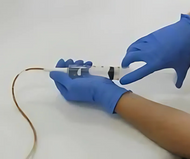August 14, 2025
How to Clear Feeding Tube Blockages: A Step-by-Step Guide
Feeding tubes are essential for delivering nutrition and medication when oral intake isn’t possible. But just like any device, they can experience issues—one of the most common being a blockage. Whether due to medication buildup, formula residue, or improper flushing, a clogged feeding tube can disrupt care and cause discomfort.
In this guide, we’ll walk you through how to clear feeding tube blockages, when to call for help, and how to prevent them in the future.
What Causes Feeding Tube Blockages?
Blockages in feeding tubes can occur due to:
- Thick formula or medication residue
- Infrequent or improper flushing
- Mixing medications with feeding formula
- Crushed or undissolved pills
- Kinked or pinched tubing
Signs of a Clogged Feeding Tube
Watch for these common signs of a blockage:
- Resistance when flushing with water
- Alarm from the feeding pump (if used)
- Leakage around the tube site
- Inability to administer food or medication
How to Clear a Feeding Tube Blockage: Step-by-Step
⚠️ Important: Always consult a healthcare provider before attempting to clear a blockage. Follow facility protocols or manufacturer instructions.
What You’ll Need:
- Warm water (not hot)
- 30-60 mL syringe
- Gentle back-and-forth pressure
- Enzyme-based declogging products (optional)
- Carbonated beverage (as instructed by your provider)
Step 1: Stop the Feeding
Pause all feedings and medications. Clamp the tube if necessary.
Step 2: Flush with Warm Water
Use a syringe to gently flush the tube with 10–20 mL of warm water. Do not use force—it could damage the tube.
Step 3: Alternate Push-and-Pull Technique
If water isn’t flowing:
- Gently pull and push the plunger to dislodge the clog.
- Wait a few minutes, then try flushing again.
Step 4: Try Declogging Solutions
If water doesn’t work:
- Use an enzyme-based declogging solution or a carbonated beverage (only with medical approval).
- Let it sit for 15–30 minutes.
- Try flushing again with warm water.
Step 5: Contact a Healthcare Provider
If the blockage remains after several attempts, do not force it. Call a medical professional immediately.
What NOT to Do
- ❌ Don’t use acidic juices like lemon or orange (they can make the clog worse)
- ❌ Don’t use metal tools or wires to poke the tube
- ❌ Don’t force the plunger if there’s resistance
How to Prevent Feeding Tube Blockages
Prevention is key. Here’s how to reduce the risk of future clogs:
✅ Flush the tube with warm water:
- Before and after feedings
- Before and after medication
- Every 4–6 hours if continuous feeding is in use
✅ Use liquid medications when possible
✅ Crush and dissolve pills thoroughly (only with provider approval)
✅ Flush between multiple medications
When to Seek Medical Help
Call your healthcare provider if:
- You can’t clear the blockage after several tries
- There’s leakage, redness, or swelling at the tube site
- The person shows signs of distress or discomfort
Feeding tube blockages are common, but with the right technique and regular care, they can often be managed at home. Always follow your provider’s instructions and use only recommended products to ensure safety and comfort.
Need feeding tube supplies or declogging tools?
SHOP HERE for trusted products that support better care at home.

